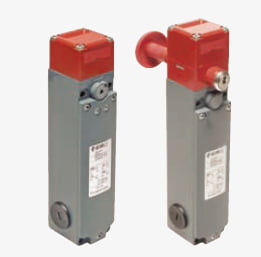Metal Body Safety Switches with Solenoid and Separate Actuator
Main Data
- Actuator holding force 2500 N
- 10 contact blocks with 4 poles
- Metal housing, three conduit entries M20
- Protection degree IP67
- Version with lock release device and emergency release push button
- 4 stainless steel actuators
- Rotating head and devices and not detachable
- Signalling LED
- Working with energized or de-energized solenoid
Description
These switches are used on machines where the hazardous conditions remain for a while, even after the machines has been switched off, for example because of mechanical inertia of pulleys, saw disks, parts under pressure or with high temperatures. They can also be used when it is necessary to control machine guards allowing the opening of protections only under specific conditions.
Working conditions
The working principle of these safety switches allows three different working states:
state A : with the actuator inserted and blocked by the solenoid
state B : with the actuator inserted but not blocked
state C : with the actuator extracted
All or some of these states may be controlled through the positive opening contacts of the internal contact block.

Actuator holding force
The strong interlocking system guarantees a maximum actuator holding force of 2500 N.
Actuating regulation zone
This switch has a wide backlash of the actuator into the head (4,5 mm) to avoid that door gaskets keep in traction the
actuator on the solenoid. With closed door, check that the actuator doesn’t knock straight against the head of the switch; it must be in the adjustment zone (0.5…5 mm)
Rotating heads and devices
The head can be quickly rotated on each of the 4 sides of the switch by unfastening the four fixing screws. Also the lock release device and the release button can be rotated in 90° steps; this enables the switch to assume 32 different configurations.
4 poles contact block
Innovative 4 poles contact block, available in different contacts configurations to monitor the actuator or the solenoid
(patented). The contact block is supplied with no-loosing screws and self-lifting plates
Not detachable head & devices
The head and the release devices can be rotated but they are not detachable to each other. In such a way the switch is safer because the installer do not have to worry about the assembly of various components and there is a lower probability of damages (loss of small parts, dirt penetration, etc.)
Release device with rotating lock
The auxiliary release device with rotating lock is used to allow the maintenance or the entry into the machinery to authorized personnel only. Rotating the key, will make the same action of the solenoid, that is move solenoid contacts and release the actuator. The device can be rotated allowing the installation of the safety switch inside the machinery and making the release device accessible outside the protection. In this way, the switch is more protected against possible tampering and the external side/surface of the machinery remains pleasant.
Emergency release push button
This device is used when the safety switch controls hazardous areas where operators may physically enter with all
their body. The release button, oriented towards inside the machinery, allows the exit of the operator accidentally trapped also in case of possible black-out. Pushing the button, it will be actuated the same function of the auxiliary release device. To reset the switch, restore the button to the initial position. The emergency button can be rotated, is available with different lengths and is fixed to the switch by a screw, so to allow the installation of the switch inside or outside the guards.
Lock release device and emergency push button
This device performs the two above mentioned functions at the same time. Also in this case the device can be rotated and the release button can be ordered with different lengths. The activation of the button has the priority on the lock, that is with the closed lock is possible to activate the button and unlock the switch. To reset the switch is necessary to restore lock and button to their initial position.
